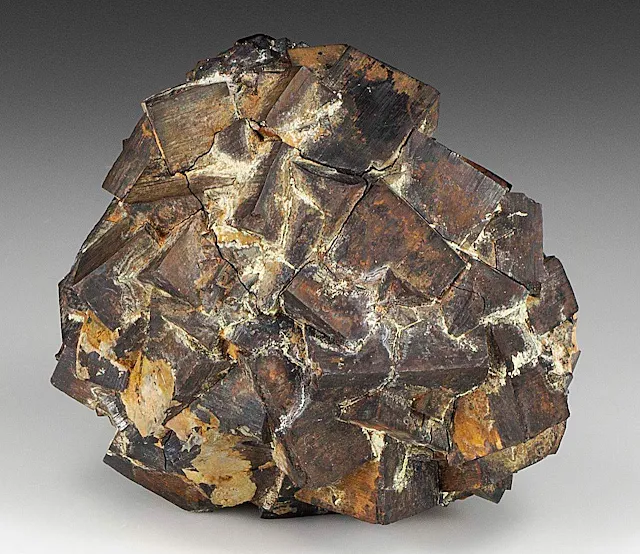Pseudomorph Minerals
Pseudomorph is a mineral formed by chemical or structural change of another substance, though retaining its original external shape. Although pseudomorphs give the appearance of being crystalline, they are commonly granular and waxy internally and have no regular cleavage; those that are crystalline have optical properties different from those required by their outward form.
They retain the external shape and form of a pre-existing mineral, called the protolith, but their internal composition has been transformed into a different mineral, called the neomorph. Imagine a mineral wearing a mask, its true chemical identity hidden beneath the familiar form.
A common example of this is petrified wood, in which all the cellulose fibres have been replaced by silica, even those in the bark. Pseudomorphs can be formed by deposition of one mineral on the surface of crystals of another (see also epitaxy).
Types of Pseudomorphism
The metamorphosis of a protolith into a pseudomorph can occur through various mechanisms, giving rise to different types:
Substitution Pseudomorphs
These are the most common, where the protolith gradually dissolves, molecule by molecule, while the neomorph simultaneously takes its place. Think of it as meticulously rebuilding a brick wall one by one, preserving the overall structure. A classic example is malachite pseudomorph after azurite, where the vibrant blue azurite surrenders its form to the deep green malachite.
 |
| Malachite pseudo. after Azurite Photo: The Arkenstone, iRocks.com |
Deposition Pseudomorphs
Sometimes, the protolith's demise paves the way for a new arrival. As the original mineral dissolves, a new mineral deposits itself on the remaining empty space, creating a cast of the original form but with a different material. Limonite pseudomorphs after pyrite exemplify this transformation, where the golden pyrite transforms into a rusty brown limonite shell.
- A) Pseudomorphism by incrustation
- B) Pseudomorphism by infiltration
 |
| Limonite pseudomorphs after pyrite Photo: Weinrich Minerals |
Alteration Pseudomorphs
Not all transformations involve complete dissolution. In some cases, a mineral undergoes a chemical or structural makeover without losing its overall shape. Think of it as a home renovation that retains the original footprint. Calcite pseudomorphs after aragonite represent this type of change, where the aragonite rearranges its internal structure to become calcite while maintaining its crystal shape.
- A) Paramorphism
- B) with loss of ingredients
- C) with gain of ingredients
- D) with exchange of ingredients
Alteration Pseudomorphs
Similar to substitution pseudomorphs, alteration involves partial transformation of the original mineral (protolith) into a new one (neomorph). This occurs when the protolith undergoes a chemical reaction, often on exposed surfaces, resulting in a change in composition while retaining the original crystalline form. The core of the pseudomorph might still contain unaltered protolith material.
Paramorphs
A specific type of alteration pseudomorph, paramorphs (also called allomorphs), experience a change at the molecular level. They maintain their original form and chemical composition but exhibit a different molecular structure. This usually involves the replacement of the protolith by one of its dimorphs, minerals with the same chemical formula but different atomic arrangements. Examples include brookite pseudomorphs after rutile, both with the formula TiO₂.
Epimorph
Unlike substitution or alteration, epimorphs don't involve replacement of the protolith's material. Instead, the original mineral is either coated by another mineral or fills the mold left by a dissolved mineral. The original may or may not have dissolved, and in the case of dissolution, the resulting pseudomorph is sometimes called a "cast."
 |
| Cuprite Altering to Copper Photo: The Arkenstone, iRocks.com |
Loss of Constituent
Here, the protolith loses an element or compound, changing its composition but retaining its form. For instance, cuprite loses oxygen to form copper.
Addition of Constituent
The opposite of above occurs, with the protolith gaining an element or compound. An example is anhydrite adding water to form gypsum.
Exchange of Constituents
Elements or compounds are swapped between the protolith and another mineral, resulting in a new composition while preserving the form. Feldspar losing potassium silicate and gaining water to become kaolinite illustrates this process.
Often, pseudomorphs exhibit characteristics of more than one of these classes presented.
Importance of Pseudomorphs
These masked minerals are more than just geological oddities. They offer valuable insights into:
Paleoenvironmental conditions: The minerals involved in pseudomorph formation can reveal the temperature, pressure, and chemical composition of the environment where they formed.
Mineralizing fluids: Studying the composition of pseudomorphs can shed light on the fluids that transported and deposited the minerals involved.
Geological processes: Different types of pseudomorphs point to specific geological events, such as weathering, hydrothermal alteration, or metamorphism.
Read also:
Crystal Formations and Their Meanings
What Causes the Colour of Gemstones?
How to Identify Common Minerals?
Minerals Examples with Photos


%20(1).webp)






